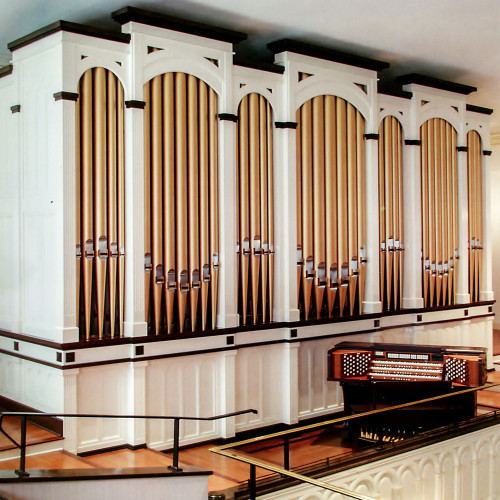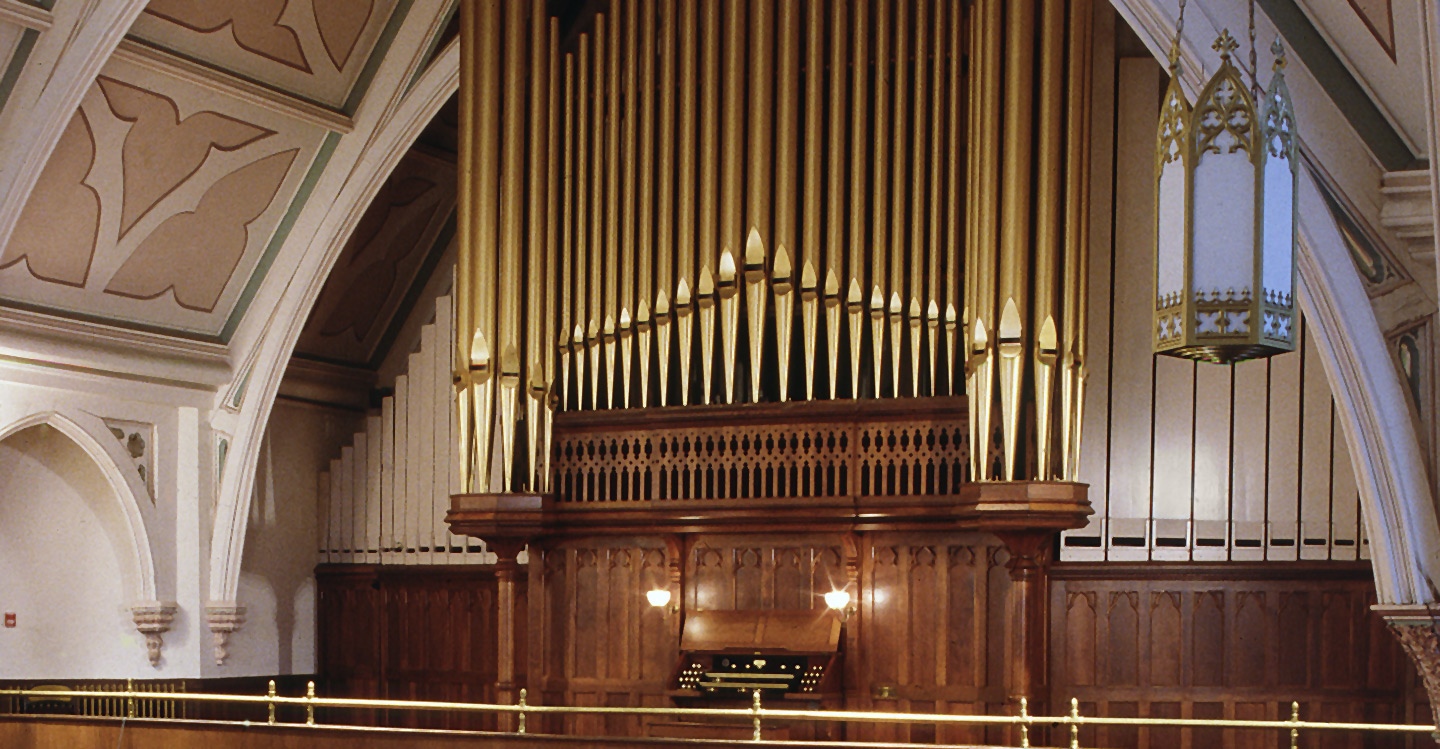Reading, PA Trinity Lutheran Church – Reading, Pennsylvania

As with any organ we design, the acoustical properties of the room dictate the overall parameters within which we can work. Trinity’s acoustic is not entirely unfriendly to organ sound, but neither does it give us the long, even reverberation times historically associated with the best examples of the organbuilders’ art. The visual proportions of the room and new organ case create the illusion of greater size, even though the acoustic remains rather intimate. The organ’s scaling, voicing and pipe treatments also work within that intimacy to create a sound that matches the visual illusion without causing aural discomfort.
Of course, the total volume of the Full Organ has to be capable of inspiring a full congregation in singing a favorite hymn on the most festive occasion. But our goal is to achieve that powerful effect not through sheer decibels, but equally through the strength with which the various elements combine and interlock. We believe this approach makes more of the organ available to be used in a wider variety of ways, and expands the color palette for the organist.
Respectful of the congregation’s celebration of its history, a few selected stops from the previous Austin organ is incorporated, including two stops that Austin had retained from the original Johnson organ before it. Our signature low-profile movable AGO console will be accompanied by an entirely new chassis, slider and unit windchests, expression boxes with extra thick expression blades, and new winding system. All of this will be packaged in an in-house built Federalist-style case, with architectural details perfectly matched to the room.
If one were to compare the sound of the new organ to the old, the new one is richer in texture, energy, color and clarity. Beautiful sound fills the room but does not overpower it. Individual stops are noteworthy for their own color, but even more so for the way they meld with other stops to create new sounds. Greater emphasis on the midrange frequencies closest to the human singing voice, rather than the extreme highs or lows gives the music breadth, yet allows the listener room to breathe.
| Great | Swell (Enclosed) | Positive (Enclosed) | Pedal |
| 16’ Lieblich Gedackt | 16’ Lieblich Gedackt | 8’ Gemshorn | 32’ Resultant |
| 8’ Principal | 8’ Geigen Principal | 8’ Gedackt | 16’ Principal |
| 8’ Bourdon | 8’ Rohrflute | 8’ Dolce | 16 ’ Violone |
| 8’ Viola da Gamba | 8’ Flauto Traverso | 8’ Dolce Celeste t.c. | 16’ Subbass |
| 8’ Flauto Traverso | 8’ Viola da Gamba | 4’ Spitzprincipal | 16’ Lieblich Gedackt |
| 8’ Dolce Celeste II | 8’ Voix Celeste t.c. | 4’ Koppel Flute | 8’ Octave |
| 4’ Octave | 4’ Principal | 2’ Block Flute | 8’ Subbass |
| 4’ Spitzflute | 4’ Viola | 11/3′ Larigot | 8’ Gemshorn |
| 22/3′ Twelfth | 4’ Harmonic Flute | II Sesquialtera t.c. | 8’ Rohrflute |
| 2’ Fifteenth | 2’ Octave | III Mixture | 4’ Choral Bass |
| 13/5′ Seventeenth | 2’ Flute | 8’ Cromorne | 4’ Flute Traverso |
| III – IV Fourniture | IV Plein Jeu + 2’ | 16’ Posaune | IV Mixture |
| 16’ Bassoon | 16’ Bassoon | 8’ Trumpet | 32’ Cornet |
| 8’ Trumpet | 8’ Trompette | 4’ Clarion | 16’ Posaune |
| 8’ Trompette | 8’ Oboe | Tremulant | 16’ Bassoon |
| 8’ Cromorne | 4’ Clarion | 8’ Trumpet | |
| 4’ Clarion | 8’ Vox Humana | 8’ Trompette | |
| Chimes | Tremulant | 4’ Clarion | |
| Zimbelstern | 4’ Cromorne | ||
| Contains most typical inter and intra manual couplers and MIDI. | |||

